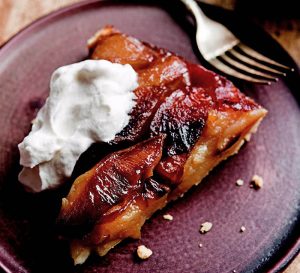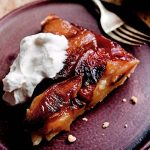 There’s no arguing with centuries of French diners—but to my taste, the flavor of the apples in the standard brasserie tarte tatin is overpowered by sugar and butter. Cutting down on those two ingredients makes the apples more assertive and brings their inherent sweetness forward. I also substituted maple syrup (grade B, the deep dark kind) for some of the sugar, a natural combination, since apple trees and maple trees often thrive on the same Vermont hillsides. The French tarte tatin is made with Reinette apples. The closest to those in America are Golden Delicious, which, like the Reinette, maintain their structure while baking and are able to absorb flavor. One of the great delights in baking is that moment when you flip the tarte tatin out of the skillet to behold the dark golden color of apples and to breathe in the seductive aroma.
There’s no arguing with centuries of French diners—but to my taste, the flavor of the apples in the standard brasserie tarte tatin is overpowered by sugar and butter. Cutting down on those two ingredients makes the apples more assertive and brings their inherent sweetness forward. I also substituted maple syrup (grade B, the deep dark kind) for some of the sugar, a natural combination, since apple trees and maple trees often thrive on the same Vermont hillsides. The French tarte tatin is made with Reinette apples. The closest to those in America are Golden Delicious, which, like the Reinette, maintain their structure while baking and are able to absorb flavor. One of the great delights in baking is that moment when you flip the tarte tatin out of the skillet to behold the dark golden color of apples and to breathe in the seductive aroma.
— Bill Yosses
Get the recipe: Use Bill’s Flaky Piecrust recipe to make this tart.
• ON-DEMAND: Listen to Faith and Bill describe this recipe, as well as others from the book. •
 Reprinted from The Sweet Spot by arrangement with Pam Krauss Books, a member of Penguin Group (USA) LLC, A Penguin Random House Company. Copyright © 2017, Bill Yosses. Photo Copyright © Evan Sung.
Reprinted from The Sweet Spot by arrangement with Pam Krauss Books, a member of Penguin Group (USA) LLC, A Penguin Random House Company. Copyright © 2017, Bill Yosses. Photo Copyright © Evan Sung.
- 1 tablespoon Turbinado sugar
- 2 tablespoons unsalted high-fat European-style butter
- 1 tablespoon grade B maple syrup
- 8 Golden Delicious apples peeled, cored, and quartered
- 1 Flaky Piecrust dough (see recipe link above)
- Maple Whipped Cream (see recipe below)
- Preheat the oven to 375°F.
- Combine the sugar and 1 tablespoon water in a 9-inch cast-iron skillet and cook over medium heat, swirling the mixture in the pan until the sugar is dissolved; it will immediately begin to bubble and caramelize around the rim of the pan. Cook until the liquid is mahogany in color and has reduced by half. When it begins to smoke and turns deep dark brown, remove the pan from the heat and carefully add the butter and maple syrup. Swirl it around to coat the bottom of the skillet.
- Arrange about half the apples in the skillet, flat side down, in concentric circles, packing them tightly. Arrange the remaining apples on top in a second layer, tucking them in tightly (you need at least two layers of apples because they shrink). Place the skillet over medium heat and bring the syrup mixture to a boil. Leave the pan on the heat until the apples begin to release their juices and get a head start cooking, about 7 minutes more. Remove the pan from the heat.
- Roll out the dough to 1⁄8-inch thickness and 2 inches larger than the diameter of the cast-iron pan. Roll the dough back onto the rolling pin like a carpet. Unroll the dough over the apples in the skillet. Carefully tuck the edges of the dough in between the apples and the edge of the skillet. Transfer to the oven and bake for 30 minutes. (The kitchen should be smelling pretty good by then.) Reduce the heat to 350°F and bake 30 minutes more. Insert a toothpick into the tarte through an apple slice; if it slides in easily, the tarte is done.
- Remove from the oven and set aside on the counter, sliding a fork underneath the skillet to allow airflow. Let cool for 10 minutes. Run a sharp knife around the rim of the tarte, then, wearing oven mitts (the molten caramel can burn you if it escapes), top the skillet with an overturned rimmed plate and flip it over. Remove the skillet. Serve warm with a dollop of Maple Whipped Cream.
Maple Whipped Cream
Ingredients:
½ cup heavy cream
2 tablespoons granulated maple sugar
Directions:
Place the bowl and whisk attachment of a standing mixer in the refrigerator for 10 minutes.
Return the bowl and whisk to the mixer and pour the cream into the bowl. Whisk on medium-high speed until soft peaks form and the tines of the whisk begin to show in the cream. Add the sugar and whisk for 30 seconds more. Remove the bowl from the mixer, and using a hand whisk, finish whisking to stiff peaks. The whipped cream will keep in the refrigerator, tightly covered, overnight. Whisk before serving.


